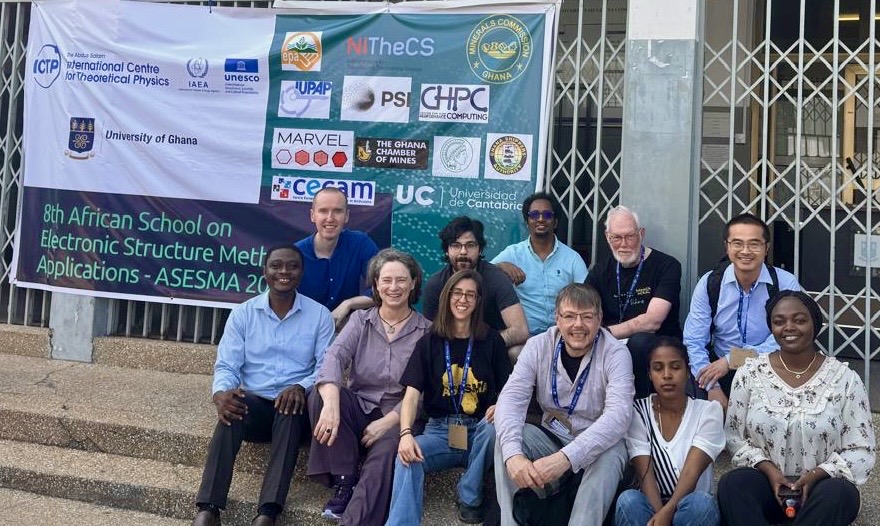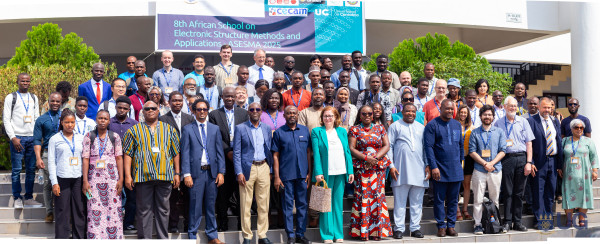Another highly successful edition for the ASESMA school
The eighth edition of the African School on Electronic Structure Methods and Applications (ASESMA) took place in Accra, Ghana, from 9 to 20 June 2025. The school is organized every two years, led by the International Centre for Theoretical Physics (ICTP) in Trieste and co-sponsored by MARVEL, CECAM and ETH4D (Swiss funding scheme for collaborations with the Global South) among others.
ASESMA aims to introduce African researchers to the quantum-mechanical electronic-structure theory and atomistic simulation methods. This edition involved 51 participants, from 17 different African countries, selected from over 170 applications.
“The school really brings the continent together, enabling also people who live in quite complicated situations to have high-quality training opportunities” says CECAM deputy director Sara Bonella, a speaker at the school and one of several MARVEL members who contributed to this edition.
The programme covered two weeks. The first one was dedicated to theory and exercises. “The mornings were for lectures, while in the afternoon students were divided in two groups, the basic and the advanced one”, explains Chiara Cignarella, a member of Nicola Marzari’s group at the University of Bremen and previously at EPFL. The basics group was for newcomers who had no prior knowledge of density-functional theory (DFT), while the advanced one for those already familiar with it, including many returning students who had already participated in previous ASESMA editions. "This new approach provided a valuable platform for interaction and potential research collaborations between the two groups" points out Garu Gebreyesus from the University of Ghana, the local organizer.
In the evenings there was room for lighter moments, with games and role-plays where participants were invited to reflect on problems that scientists face – from misconduct to gender unbalance in research.

In the picture:First row (from left to right): Iurii Timrov, Alberto Carta, Garu Gebreyesus, Richard M. Martin, Houlong Zhuang. Second row (from left to right): Martin Egblewogbe, Sara Bonella, Chiara Cignarella, Christian Carbogno, Liya Gebrehiwot, Abezu Agegnegu.
The second week was dedicated to the development projects. “Depending on each participant’s level, they were assigned by instructors to projects that ranged from self-contained to more advanced ones, potentially leading to publications” says Alberto Carta, a researcher at the Paul Scherrer Institute currently under MARVEL. In addition there were specialized topical seminars, in particular some dedicated to quantum computing, tuned to this year’s International Year of Quantum.
The preparation of the programme was coordinated by Iurii Timrov from the Paul Scherrer Institute together with the core leaders of ASESMA - Richard M. Martin (University of Illinois and Stanford University, USA), Shobhaba Narasimhan (Jawaharlal Nehru Centre for Scientific Research, India), Nicola Seriani (ICTP, Italy) among others - who all were the co-directors of this year’s edition. Cignarella and Carta, as well as Edrick Solis Gonzalez, a MARVEL PhD student in the CECAM lab, contributed significantly to the hands-on sessions, also making sure beforehand that all computers were adequately equipped to run simulations.
“It seems it was the most successful edition so far” says Iurii Timrov, “and a lot of credit goes to Garu Gebreyesus from the University of Ghana, the local organizer, who did a fantastic job preparing the event and taking care of all participants and lecturers”.
Gebreyesus agrees that this was a particularly successful edition. "It was marked by a strong presence of advanced participants, numerous African tutors, and highly motivated newcomers. The enthusiasm of participants, lecturers, and mentors was truly inspiring, and there is clear momentum to sustain and build on this spirit in future editions", he says.

Left to right: Garu Gebreyesus, Richard Martin and Iurii Timrov
After eight editions, the impact of the programme on African science is considerable, says Sara Bonella. “The number of people who started in ASESMA and now are faculty across different African countries is significant. We’ve seen people attending past ASESMA editions in the very early stage of their career, and now they keep attending it in evolving roles, getting positions also thanks to what they have done here”. Beyond that, the programme is creating networks, and that happens both with the two-week school and with ASESMANET, a spin-off programme that supports intra-African and Africa-Europe mobility and research visits.
The goal for the next editions, says Timrov, is to see more and more African scientists take care of lectures and hands-on sessions, gradually replacing external scientists. “This way the programme can become sustainable, without depending too much on external partners”.
The next edition will be in two years, with the location still to be decided.

Low-volume newsletters, targeted to the scientific and industrial communities.
Subscribe to our newsletter